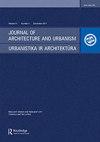NORMATIVE APPROACHES IN MAKING CULTURAL QUARTERS AND ASSESSMENT OF CREATIVE INDUSTRY PARKS IN SHANGHAI
IF 0.8
0 ARCHITECTURE
引用次数: 3
Abstract
This article aims to synthesize the principles of making cultural quarters in literature and test their applicability in creative industry parks in the Chinese context. Extant literature on creative industry parks in China lacks an evaluation instrument for evaluating the performance of creative industry parks. This research reviews normative theories regarding cultural quarter making and identifies three approaches, namely the area-based approach in cultural quarter design, architectural design principles (tailored to cultural quarters), and a comprehensive framework that comprises three dimensions, i.e., activity, built form, and meaning. These normative approaches were applied to evaluate the quality of creative industry parks that emerged in Shanghai in the recent decade. Qualitative research methods, including on-site reconnaissance, observation, and interview, were adopted. The former two approaches revealed good design practices in Shanghai’s creative industry parks. A systematic evaluation of the said parks through a comparative study suggests significant disparity in the dimensions of architectural design and place making. Additionally, indicators of state support for micro and small creative industry companies and arts funding are less applicable in Shanghai. These findings reveal the role of the private sector in constructing a diversified creative environment which was previously enshrined by the state. With these outcomes, this research partially endorses the value of the normative theories to guide the practice of making and evaluating cultural quarters in the Chinese context.上海文化园区建设与创意产业园区评估的规范方法
本文旨在综合文献中文化区的制作原则,并在中国背景下检验其在创意产业园区中的适用性。国内现有的创意产业园研究文献缺乏一种评价工具来评价创意产业园的绩效。本研究回顾了有关文化街区制作的规范理论,并确定了三种方法,即文化街区设计的区域导向方法,建筑设计原则(针对文化街区),以及包含三个维度的综合框架,即活动,建筑形式和意义。运用这些规范方法对近十年来上海涌现的创意产业园质量进行了评价。本研究采用定性研究方法,包括现场调查、观察和访谈。前两种方法揭示了上海创意产业园区的良好设计实践。通过比较研究对上述公园进行系统评价,发现在建筑设计和场所营造的维度上存在显著差异。此外,国家对小微创意产业公司和艺术资助的支持指标在上海也不太适用。这些发现揭示了私营部门在构建多元化创意环境方面的作用,而这在以前是由国家所推崇的。通过这些研究结果,本研究在一定程度上支持了规范理论在指导中国语境下文化街区的构建和评估实践中的价值。
本文章由计算机程序翻译,如有差异,请以英文原文为准。
求助全文
约1分钟内获得全文
求助全文
来源期刊

Journal of Architecture and Urbanism
ARCHITECTURE-
CiteScore
1.30
自引率
14.30%
发文量
12
审稿时长
15 weeks
期刊介绍:
The Journal of Architecture and Urbanism publishes original research on all aspects of urban architecture.
 求助内容:
求助内容: 应助结果提醒方式:
应助结果提醒方式:


